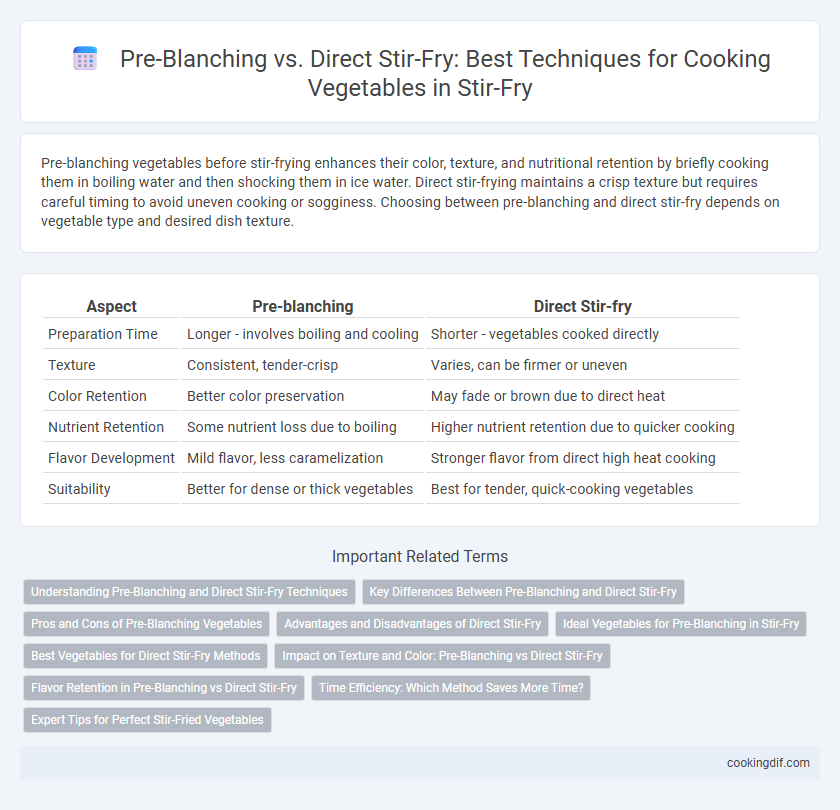Pre-blanching vegetables before stir-frying enhances their color, texture, and nutritional retention by briefly cooking them in boiling water and then shocking them in ice water. Direct stir-frying maintains a crisp texture but requires careful timing to avoid uneven cooking or sogginess. Choosing between pre-blanching and direct stir-fry depends on vegetable type and desired dish texture.
Table of Comparison
| Aspect | Pre-blanching | Direct Stir-fry |
|---|---|---|
| Preparation Time | Longer - involves boiling and cooling | Shorter - vegetables cooked directly |
| Texture | Consistent, tender-crisp | Varies, can be firmer or uneven |
| Color Retention | Better color preservation | May fade or brown due to direct heat |
| Nutrient Retention | Some nutrient loss due to boiling | Higher nutrient retention due to quicker cooking |
| Flavor Development | Mild flavor, less caramelization | Stronger flavor from direct high heat cooking |
| Suitability | Better for dense or thick vegetables | Best for tender, quick-cooking vegetables |
Understanding Pre-Blanching and Direct Stir-Fry Techniques
Pre-blanching vegetables involves briefly boiling them to preserve color and texture before stir-frying, which enhances even cooking and reduces overall stir-fry time. Direct stir-fry skips the boiling step, relying on high heat and quick cooking to retain maximum nutrients and a crisp texture. Choosing between pre-blanching and direct stir-fry depends on vegetable type, desired texture, and cooking speed.
Key Differences Between Pre-Blanching and Direct Stir-Fry
Pre-blanching vegetables involves briefly boiling them before stir-frying, which helps maintain vibrant color, improves texture, and reduces overall cooking time. Direct stir-fry cooks vegetables quickly at high heat, preserving a crisp texture and fresh taste but may result in uneven cooking for denser vegetables. Choosing between pre-blanching and direct stir-fry depends on the vegetable type, desired texture, and cooking speed.
Pros and Cons of Pre-Blanching Vegetables
Pre-blanching vegetables before stir-frying preserves vibrant color and enhances texture by partially cooking and softening them, reducing overall stir-fry time. However, this method can lead to nutrient loss, particularly water-soluble vitamins like vitamin C and B-complex, and may diminish the fresh, crisp bite associated with direct stir-frying. Pre-blanching offers better control over cooking consistency but requires extra preparation steps and equipment such as boiling water and ice baths.
Advantages and Disadvantages of Direct Stir-Fry
Direct stir-fry preserves maximum nutrients and vibrant colors in vegetables due to the short cooking time at high heat, enhancing texture with a crisp-tender bite. It saves preparation time and reduces water usage compared to pre-blanching, making it an efficient method for quick meals. However, direct stir-frying may result in uneven cooking and can cause some vegetables to remain undercooked or dry, especially those with denser textures.
Ideal Vegetables for Pre-Blanching in Stir-Fry
Ideal vegetables for pre-blanching in stir-fry include broccoli, green beans, asparagus, and carrots due to their dense texture and longer cooking times. Pre-blanching these vegetables helps maintain vibrant color, crisp-tender texture, and reduces overall stir-fry time. Leafy greens and softer vegetables like bell peppers and mushrooms are better suited for direct stir-frying, as they cook quickly and retain their flavor without pre-treatment.
Best Vegetables for Direct Stir-Fry Methods
Vegetables like bell peppers, snap peas, and broccoli florets excel in direct stir-fry methods due to their quick cooking times and ability to retain crisp texture. Direct stir-frying preserves the natural color and nutrients of these vegetables by exposing them to high heat for a short duration. Avoid dense or starchy vegetables such as potatoes or carrots without pre-blanching, as they require longer cooking to achieve tenderness.
Impact on Texture and Color: Pre-Blanching vs Direct Stir-Fry
Pre-blanching vegetables before stir-frying preserves vibrant color and ensures a crisp-tender texture by partially cooking and halting enzyme activity. Direct stir-frying often results in uneven cooking and a duller appearance due to the rapid high heat exposure. Choosing pre-blanching enhances visual appeal and maintains optimal texture, especially for denser vegetables like broccoli or carrots.
Flavor Retention in Pre-Blanching vs Direct Stir-Fry
Pre-blanching vegetables before stir-frying helps preserve their vibrant color and natural flavor by halting enzymatic activity that causes flavor degradation. Direct stir-fry exposes vegetables to high heat immediately, which can lead to uneven cooking and potential loss of delicate flavors through excessive moisture evaporation. Pre-blanching followed by quick stir-frying balances texture and flavor retention, ensuring crispness and enhanced taste in the final dish.
Time Efficiency: Which Method Saves More Time?
Pre-blanching vegetables before stir-frying can save time by partially cooking and softening them, reducing overall stir-fry duration. Direct stir-fry skips the blanching step, but may require longer cooking to achieve desired tenderness, especially for denser vegetables like broccoli or carrots. For quick meals, pre-blanching optimizes time efficiency by balancing cooking speed and texture quality.
Expert Tips for Perfect Stir-Fried Vegetables
Pre-blanching vegetables before stir-frying helps retain vibrant color, enhances texture, and speeds up cooking by partially softening tougher fibers. Direct stir-frying preserves more nutrients and offers a crispier bite, but requires precise timing to avoid undercooked or burnt pieces. Experts recommend blanching dense vegetables like broccoli or carrots, while tender greens like spinach can be added directly to optimize flavor and texture balance.
Pre-blanching vs direct stir-fry for vegetables Infographic

 cookingdif.com
cookingdif.com